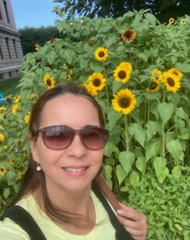Featured Educator: Adriane Cioppa

In this edition of WIDA Featured Educator, we introduce you to Adriane Cioppa, an English as a Second Language (ESL) specialist at John F. Kennedy School and Next Wave/Full Circle Schools in Somerville, Massachusetts. Adriane has been a teacher in Somerville for 24 years!
Let’s get to know Adriane!
Note: The following content has been lightly edited for clarity and length.
What do you teach?
For the past six years, I have been an ESL specialist. Before that, I spent 18 years as a second grade teacher in a sheltered English immersion class.
Why did you choose to become an educator?
Since I was a little girl, I wanted to become a teacher. I always admired and appreciated the idea that I could transfer my knowledge to others and help them to be better prepared for life and succeed, and that I could make a positive difference in a person’s life. I always loved children, so it was a natural path for me to become a teacher.
Tell us about your students.
I have a total of 37 students from grades K-12 divided between three schools. My students come from many different parts of the world, such as Morocco, Italy, Saudi Arabia, China, Japan, Tibet, Portugal, Brazil, El Salvador, the Domenic Republic, Haiti, Bangladesh, and many other places.
What do language services look like in your school?
As an ESL specialist, I do both push-in and pull-out classes. When I pull out students, I work with them in small groups providing instruction in English in reading, writing, listening and speaking. When I push into the mainstream classes, I provide my students with language support and content-based instruction, in addition to some team teaching with the classroom teacher. I also provide ESL instruction to children with mild to severe and profound disabilities, which has become a passion of mine.
What tactics do you use to support language learning in your classroom and school?
There are many different approaches I use in my ESL instruction in the classroom. First of all, I have to make sure my students feel welcomed and supported. I do that by asking them to share some facts about their native country and incorporate some of their native languages in class. I make them feel respected and appreciated because they need to feel safe in order to be open to learning. To support language, I do a lot of modeling, mini lessons teaching core vocabulary, and creating activities that will increase their engagement and interactions, such as games where students have to socialize and speak in class. I also use slide shows, videos, music, word banks, sentence frames and graphic organizers to help my students’ comprehension skills.
What strategies have you found to be most effective in teaching multilingual learners with cognitive disabilities?
To teach dually-identified students, I consistently incorporate multiple repetitions of new and/or unfamiliar vocabulary words, use visuals and graphic organizers, break up the lessons and assignments into small steps, use a multisensory approach, and always differentiate to meet students' needs.
How do you encourage students to learn?
The first thing I have to do is make my students feel safe and welcome in my classroom. I also promote a growth mindset instead of a fixed mindset. I establish high expectations and clear goals. I try to make the lessons interactive and fun with hands-on activities when possible. I pre-teach vocabulary and activate background knowledge to increase comprehension, provide targeted instruction, and use scaffolds to help students understand complex language and text features.
How do you collaborate with content area teachers and special education teachers? Are there any specific strategies that you use?
I work closely with my content teachers and special education teachers. I try to push into the classroom as often as possible and help the teachers develop language goals for the lessons and students according to their needs. I often meet with my teachers to discuss our students’ needs and the necessary scaffolds that will support them during the lesson.
What are some of your favorite in-classroom resources that help you support your multilingual learners?
My favorite resources are slide decks with visuals, hands-on activities, and of course… modeling, modeling, modeling!
What’s a fun fact about you?
I am a lifelong learner who has taken up several new hobbies in the past few years, including Argentine tango, guitar, and most recently – tennis.
As you reflect on the past year, what is a piece of advice/message that you’d like to share with your colleagues around the world?
It is not easy to learn a new language. Students need time to feel accepted and understood. Do not judge them because they are having a tough time adapting to a new country, culture and language. Talk to them, connect with them and make a positive difference in their lives.





